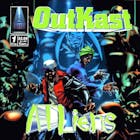
Acclaimed Artist DL Warfield Returns With Hip-Hop-Inspired Series 'CYPHERS'
Acclaimed Artist DL Warfield Returns With Hip-Hop-Inspired Series 'CYPHERS'
Published Tue, July 25, 2023 at 3:40 PM EDT
In a world that feels like it's tightrope-walking between order and chaos, art stands as a steadying force. Truly timeless art — the kind that lingers long after the artist has departed — examines our present while casting forward to envision the future. DL Warfield is that kind of artist.
A multidisciplinary artist, Warfield is the creative mind behind some of Hip-Hop and R&B's most recognizable album covers, including OutKast's ATLiens and their quadruple platinum album Stankonia, T.I.'s I'm Serious, Goodie Mob's Still Standing and One Monkey Don’t Stop No Show, Usher's Confessions, TLC's Fan Mail, and countless more. He's also the visionary behind the popular series, The AmericanFlagRemix™.
Known for his distinctive "Hop Art," a fusion of his deep-rooted love for Hip-Hop, urban culture, and fine art, Warfield's pieces have graced prominent platforms nationwide, from Miami's Art Basel to the Time-Life Building in New York. He also helms Goldfinger c.s., a boutique creative agency, orchestrating design projects for high-profile clients like luxury brand Hideoki Bespoke, Ford, Nike, and Hennessy, while leading branding and creative concepts for renowned record companies, including LaFace, Def Jam, Universal Music Group, and Motown. His artwork is proudly displayed in the homes of T.I., L.A. Reid and Usher. Warfield's creative genius is undeniably influential, with his work being associated with over $800 million in record sales to date.
Now, he's launching a new series, CYPHER, which he says is directly inspired by his continued love for Hip-Hop. A former b-boy, Warfield's work is especially fitting as we celebrate Hip-Hop's 50th anniversary. Rock The Bells caught up with the acclaimed artist to talk about his new series, and how Hip-Hop was its catalyst.


You’ve been a respected artist and designer for decades — but not everyone knows you started out as a b-boy. Talk about that journey.
I’ve always loved dance, going back to Michael and the Jackson 5, ReRun and The Lockers, to guys like Boogaloo Shrimp, Poppin’ Taco of the Electric Boogaloos and Crazy Legs from The Rock Steady Crew. 82’, ’83 is when I first started breakdancing and the inspiration was from what I was able to absorb from Soul Train and movies like Beat Street and Breakin’.
I remember the battles my crew and I had at places like the Animal House and Saints Roller Rink in St. Louis where we won the city championship and landed a commercial for Pizza Hut. I was always an athlete and down for competition but the competition I experienced while dancing felt different. The way the crowd responded was addicting. It felt creative. It felt like art. I loved that era of Hip-Hop the most. It was 100% about the art and fun. Also through breakdancing was when I got my first taste of celebrity. Our group (The Steamheat Breakers / Clockwerk Crew) became St. Louis famous, LOL. We were the dancers of our MLS team, The St. Louis Steamers and Six Flags. We were sponsored by Kangaroo Sneakers and opened up concerts from groups like New Edition, DeBarge and Herbie Hancock.
How’d that history prepare and inspire you to create Cyphers?
That history inspired and prepared me in several ways. As it relates to actually being in a CYPHER and battling for your rep, I know what that feels like. The effort, execution, anticipation and creative expression were things that we practiced daily. While photographing the dancers, I knew exactly what to look for. Over the years I’ve always thought about ways that I could portray my love for breakdancers and poppers in an elevated fine art way. I didn’t want the images to be obvious at first. I wanted them to feel like patterns similar to the movement and patterns that are created when b-boys are on the floor executing their footwork. I also have pieces in the works that feature graffiti artist, DJs, and MCs, which collectively make up the four elements of Hip-Hop.
As I thought about the courage it took for us to compete in that circle back then and how dancers these days have taken the dance form to super-human levels, I started to think about fighters and other individual sport competitors who have to get in that circle and compete, connect, take risk and inspire. I’m currently working on pieces that feature former NBA Star Mahmoud Abdul Rauf, American Sprint Champion, Christian Coleman and a few up and coming fighters.
DROP YOUR EMAIL
TO STAY IN THE KNOW
What might surprise people about this series?
The word “CYPHER” that is used in Hip-Hop comes from the Arabic word, “cipher.” That word origin helped me land on the direction of the pattern making process and lead me to researching sacred geometric shapes, mandala patterns and Islamic designs. Even though these shapes and designs origins are in Africa and India, you can see the aesthetic influence all over the world. To me, this speaks to the connectivity. I chose to create these pieces on circular wood panels because a circle is the strongest shape. It has no weakest point. Being inside the circle or (cipher) can connect us and also protect us whether it’s dancers in a battle, emcees passing the mic or fighters exchanging punches.
You’re always looking for new ways to challenge yourself creatively. In what way did this new series push you?
This series challenged me in several ways. You hit the nail on top of the head when you mention creatively challenging myself, lol. This has definitely been the most challenging. The scale and fabrication has been tough. As an artist, sometimes you can feel that each piece needs to one up the next. That is exciting and hectic at the same damn time. I’ve spent an adequate amount of time learning about revolving mechanisms and metal work as well. Every idea sparks another idea and so on. I’ve also had to do a lot of math with this series which led to me checking out some of the writings of Nikola Tesla, his 3, 6, 9 theory and shape making from vibrational patterns. Calculating spacing for the shapes and the wiring for audio for some of the pieces is a task for a non-math guy.
You’re one of the most acclaimed and prolific album art designers around. Talk about the importance of album art and what role do you think it plays in today’s music landscape.
I believe that album art is still extremely important. It still has the power to create excitement and anticipation for what the music will deliver. When it’s really good, people will stare at it forever. Before everything went digital, I think the impact was greater. You had to actually go and get it and pay with your hard earned cash. That meant something. Holding the physical product actually connected you to it. As a creative director/designer, I’d always consider the visual story told as the consumer turned from page to page. Theirappreciation meant something to me.It may have meantmore than the actual artist that I was designing forat times. Today the covers need to be more transferable because they usually end up as small digital assets. I hate it when label people ask, “how will the cover look small?” I was always thinking “how will the cover look when it’s hanging in Times Square over Tower Records and does it kick the other album covers asses when in the racks at Sam Goody!?!?” I’m dating myself [laughing]. LaFace is forever.






